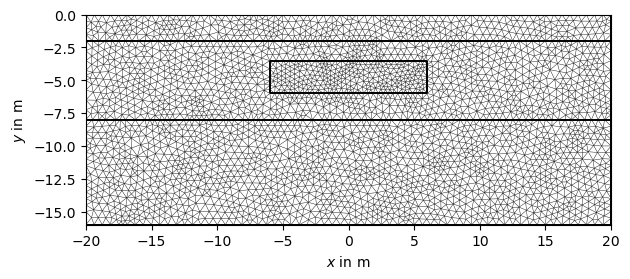Note
Go to the end to download the full example code.
Heat equation in 2D#
This tutorial solves the stationary heat equation in 2D. The example is taken from the pyGIMLi paper (https://cg17.pygimli.org).
import pygimli as pg
import pygimli.meshtools as mt
Create geometry definition for the modelling domain.
world = mt.createWorld(start=[-20, 0], end=[20, -16], layers=[-2, -8],
worldMarker=False)
# Create a heterogeneous block
block = mt.createRectangle(start=[-6, -3.5], end=[6, -6.0],
marker=4, boundaryMarker=10, area=0.1)
# Merge geometrical entities
geom = world + block
ax, cb = pg.show(geom, markers=True)

Create a mesh from based on the geometry definition.
When calling the pg.meshtools.createMesh() function, a quality parameter
can be forwarded to Triangle, which prescribes the minimum angle allowed in
the final mesh. For a tutorial on the quality of the mesh please refer to :
Mesh quality inspection [1]
[1]: https://www.pygimli.org/_tutorials_auto/1_basics/plot_6-mesh-quality-inspection.html#sphx-glr-tutorials-auto-1-basics-plot-6-mesh-quality-inspection-py
Note: Incrementing quality increases computer time, take precaution with quality
values over 33.
mesh = mt.createMesh(geom, quality=33, area=0.2, smooth=[1, 10])
ax, _ = pg.show(mesh)

Call pygimli.solver.solveFiniteElements() to solve the heat
diffusion equation \(\nabla\cdot(a\nabla T)=0\) with \(T(bottom)=0\)
(boundary marker 4) and \(T(top)=1\) (boundary marker 8), where \(a\)
is the thermal diffusivity and \(T\) is the temperature distribution.
We assign thermal diffusivities to the four # regions using their marker
numbers in a dictionary (a) and the fixed temperatures at the boundaries
using Dirichlet boundary conditions with the respective markers in another
dictionary (bc)
T = pg.solver.solveFiniteElements(mesh,
a={1: 1.0, 2: 2.0, 3: 3.0, 4:0.1},
bc={'Dirichlet': {8: 1.0, 4: 0.0}}, verbose=True)
ax, _ = pg.show(mesh, data=T, label='Temperature $T$',
cMap="hot_r", nCols=8, contourLines=False)
ax, _ = pg.show(geom, ax=ax, fillRegion=False)

Mesh: Mesh: Nodes: 3011 Cells: 5832 Boundaries: 8842
Assembling time: 0.042620584
Solving time: 0.011808987